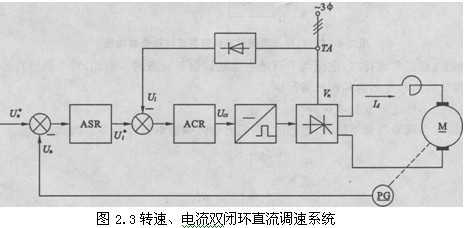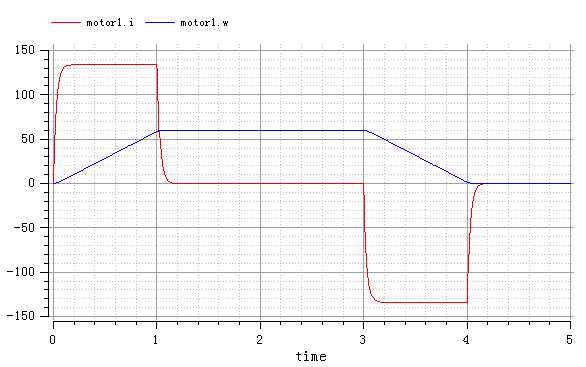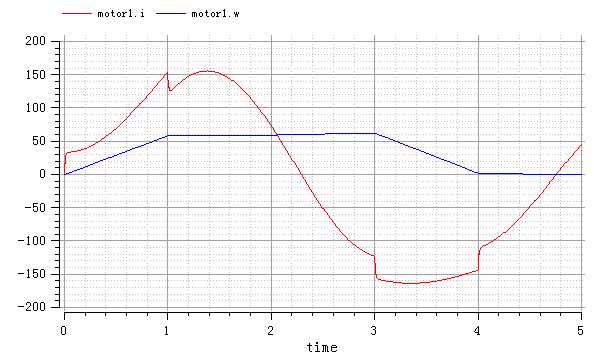直流电机调速仿真作业
Posted
tags:
篇首语:本文由小常识网(cha138.com)小编为大家整理,主要介绍了直流电机调速仿真作业相关的知识,希望对你有一定的参考价值。
直流电机调速仿真作业
左学敏 机卓1301 U201310892
一、 重写调速控制器模型Controller
使用速度环和电流环双环控制,原理图如下:

现有模型中,仅使用速度环,且控制器内仅使用P控制。
首先,引入电流环,因为电流传感器测得电压值已经定义为SensorCurrent,直接使用该变量。将控制器内反馈变量feedback改为两个反馈变量feedbackv和feedbacki,分别用于表示转速和电流的反馈值。
电流环和速度环均使用PI控制,分别定义常数Kp和Ki的值,列出相关方程,修改后控制器模型如下:
block Controller
InPort command(n=1);
InPort feedbackv(n=1);
InPort feedbacki(n=1);
OutPort outPort(n=1);
Real errorv;
Real errorvi;
Real errori;
Real errorii;
Real vout;
Real pout;
parameter Real Kp1=80;
parameter Real Ki1=15;
parameter Real Kp2=20;
parameter Real Ki2=5;
parameter Real Max_Output_Pos = 10;
parameter Real Max_Output_Neg = -10;
equation
errorv = command.signal[1] - feedbackv.signal[1];
errorv = der(errorvi);
vout = Kp1 * errorv + Ki1 * errorvi;
errori = vout - feedbacki.signal[1];
errori = der(errorii);
pout = Kp2 * errori + Ki2 * errorii;
if pout > Max_Output_Pos then
outPort.signal[1] = Max_Output_Pos;
elseif pout < Max_Output_Neg then
outPort.signal[1] = Max_Output_Neg;
else
outPort.signal[1] = pout;
end if;
end Controller;
重写控制器后,由于控制器内额外增加了电流环的内容,所以在最后的调速系统DCMotorControlSystem中添加接口定义,修改后的代码为:
model DCMotorControlSystem
Ground ground1;
Inertia inertia1(J = 3, w(fixed = true));
DCMotor motor1(J = 1,R = 0.6,L = 0.01,Kt=1.8, Ke= 1.8,rotFlange_b(phi(fixed = true)));
CommandSignalGenerator sg1;
Controller con1;
PWMVoltageSource PowerSource1;
equation
connect(sg1.outPort, con1.command);
connect(con1.feedbackv, motor1.SensorVelocity);
connect(con1.feedbacki, motor1.SensorCurrent);
connect(con1.outPort, PowerSource1.Command);
connect(PowerSource1.p, motor1.p);
connect(motor1.rotFlange_b, inertia1.rotFlange_a);
connect(PowerSource1.n, ground1.p);
connect(ground1.p, motor1.n);
end DCMotorControlSystem;
进行参数整定,直到获得较理想的转速图和电流图,运行后图像为:

此时,稳态速度误差较小,电流平稳变化,满足要求。
二、 提高要求——引入阻尼弹簧系统
电机和惯量负载通过阻尼弹簧系统相连,阻尼系数d=0.2,弹簧系数c=10。首先在单位定义模块新增两个新数据类型:
type DampingFactor = Real(quantity = "DampingFactor", unit = "N.m/(rad/s)");
type SpringConstant = Real(quantity = "SpringConstant", unit = "N.m/rad");
原模型中,电机和惯量负载通过法兰刚性连接,连接部分定义为Rigid,引入阻尼弹簧系统后,重新定义连接部分,新写了一个连接,定义为Dampingspring,其内容如下:
partial model Dampingspring
parameter DampingFactor d = 0.2;
parameter SpringConstant c = 10;
Angle phi;
Angle phic;
Angle phid;
equation
phi = phic + phid;
end Dampingspring;
本次控制中使用的是较为常见的弹簧 – 质量 – 阻尼模型,电机轴接弹簧,弹簧接惯量负载,惯量负载再接阻尼器。
模型中,phi对应电机轴转过角度,phic对应弹簧两端转过角度之差,phid对应阻尼器两端转过角度之差。
分别将惯量负载模型Inertia和电机模型DCmotor中引入的刚性连接Rigid模型改为阻尼弹簧模型Dampingspring,重写转矩平衡方程。
对于惯量负载模型Inertia:
model Inertia "1D rotational component with inertia"
extends Dampingspring;
parameter MomentOfInertia J = 1 "Moment of inertia";
AngularVelocity w "Absolute angular velocity of component";
AngularAcceleration a "Absolute angular acceleration of component";
equation
w = der(phid);
a = der(w);
J*a = c*phic - d*w;
end Inertia;
对于电机模型DCmotor:
model DCMotor "DC Motor"
extends TwoPin;
extends Dampingspring;
OutPort SensorVelocity(n=1);
OutPort SensorCurrent(n=1);
parameter MomentOfInertia J"Total Inertia";
parameter Resistance R"Armature Resistance";
parameter Inductance L"Armature Inductance";
parameter Real Kt"Torque Constant";
parameter Real Ke"EMF Constant";
AngularVelocity w "Angular velocity of motor";
AngularAcceleration a "Absolute angular acceleration of motor";
Torque tau_motor;
equation
w = der(phi);
a = der(w);
v = R*i+Ke*w+L*der(i);
tau_motor = Kt*i;
J*a = tau_motor - c*phic;
SensorVelocity.signal[1] = w;
SensorCurrent.signal[1] = i;
end DCMotor;
控制器结构不变,调速系统接口定义稍作调整,如下:
model DCMotorControlSystem
Ground ground1;
Inertia inertia1(J = 3, w(fixed = true));
DCMotor motor1(J = 1,R = 0.6,L = 0.01,Kt=1.8, Ke= 1.8, phi(fixed = true));
CommandSignalGenerator sg1;
Controller con1;
PWMVoltageSource PowerSource1;
equation
connect(sg1.outPort, con1.command);
connect(con1.feedbackv, motor1.SensorVelocity);
connect(con1.feedbacki, motor1.SensorCurrent);
connect(con1.outPort, PowerSource1.Command);
connect(PowerSource1.p, motor1.p);
connect(motor1.phi, inertia1.phi);
connect(motor1.phic, inertia1.phic);
connect(PowerSource1.n, ground1.p);
connect(ground1.p, motor1.n);
end DCMotorControlSystem;
运行成功后,进行控制器参数整定,最终在Kp1=75、Ki1=5、Kp2=50、Ki2=15时得到较理想图像,如下图:

由图像可看出,增加了阻尼弹簧系统之后,电流变得不稳定,出现较大波动,转速则出现上漂现象,调大增益值Kp之后上漂现象有所缓解,但是电流值图像出现较多毛刺。
三、附完整代码
1. 仅重写控制器,未引入阻尼弹簧:
type ElectricPotential = Real;
type ElectricCurrent = Real(quantity = "ElectricCurrent", unit = "A");
type Resistance = Real(quantity = "Resistance", unit = "Ohm", min = 0);
type Inductance = Real(quantity = "Inductance", unit = "H", min = 0);
type Voltage = ElectricPotential;
type Current = ElectricCurrent;
type Force = Real(quantity = "Force", unit = "N");
type Angle = Real(quantity = "Angle", unit = "rad", displayUnit = "deg");
type Torque = Real(quantity = "Torque", unit = "N.m");
type AngularVelocity = Real(quantity = "AngularVelocity", unit = "rad/s", displayUnit = "rev/min");
type AngularAcceleration = Real(quantity = "AngularAcceleration", unit = "rad/s2");
type MomentOfInertia = Real(quantity = "MomentOfInertia", unit = "kg.m2");
type Time = Real (final quantity="Time", final unit="s");
connector RotFlange_a "1D rotational flange (filled square)"
Angle phi "Absolute rotational angle of flange";
flow Torque tau "Torque in the flange";
end RotFlange_a; //From Modelica.Mechanical.Rotational.Interfaces
connector RotFlange_b "1D rotational flange (filled square)"
Angle phi "Absolute rotational angle of flange";
flow Torque tau "Torque in the flange";
end RotFlange_b; //From Modelica.Mechanical.Rotational.Interfaces
connector Pin "Pin of an electrical component"
Voltage v "Potential at the pin";
flow Current i "Current flowing into the pin";
end Pin; //From Modelica.Electrical.Analog.Interfaces
connector PositivePin "Positive pin of an electrical component"
Voltage v "Potential at the pin";
flow Current i "Current flowing into the pin";
end PositivePin; //From Modelica.Electrical.Analog.Interfaces
connector NegativePin "Negative pin of an electrical component"
Voltage v "Potential at the pin";
flow Current i "Current flowing into the pin";
end NegativePin; //From Modelica.Electrical.Analog.Interfaces
connector InPort "Connector with input signals of type Real"
parameter Integer n = 1 "Dimension of signal vector";
input Real signal[n] "Real input signals";
end InPort; // From Modelica.Blocks.Interfaces
connector OutPort "Connector with output signals of type Real"
parameter Integer n = 1 "Dimension of signal vector";
output Real signal[n] "Real output signals";
end OutPort; // From Modelica.Blocks.Interfaces
partial model Rigid // Rotational class Rigid
"Base class for the rigid connection of two rotational 1D flanges"
Angle phi "Absolute rotation angle of component";
RotFlange_a rotFlange_a "(left) driving flange (axis directed into plane)";
RotFlange_b rotFlange_b "(right) driven flange (axis directed out of plane)";
equation
rotFlange_a.phi = phi;
rotFlange_b.phi = phi;
end Rigid; // From Modelica.Mechanics.Rotational.Interfaces
model Inertia "1D rotational component with inertia"
extends Rigid;
parameter MomentOfInertia J = 1 "Moment of inertia";
AngularVelocity w "Absolute angular velocity of component";
AngularAcceleration a "Absolute angular acceleration of component";
equation
w = der(phi);
a = der(w);
J*a = rotFlange_a.tau + rotFlange_b.tau;
end Inertia; //From Modelica.Mechanics.Rotational
partial model TwoPin // Same as OnePort in Modelica.Electrical.Analog.Interfaces
"Component with two electrical pins p and n and current i from p to n"
Voltage v "Voltage drop between the two pins (= p.v - n.v)";
Current i "Current flowing from pin p to pin n";
PositivePin p;
NegativePin n;
equation
v = p.v - n.v;
0 = p.i + n.i;
i = p.i;
end TwoPin;
model DCMotor "DC Motor"
extends TwoPin;
extends Rigid;
OutPort SensorVelocity(n=1);
OutPort SensorCurrent(n=1);
parameter MomentOfInertia J"Total Inertia";
parameter Resistance R"Armature Resistance";
parameter Inductance L"Armature Inductance";
parameter Real Kt"Torque Constant";
parameter Real Ke"EMF Constant";
AngularVelocity w "Angular velocity of motor";
AngularAcceleration a "Absolute angular acceleration of motor";
Torque tau_motor;
RotFlange_b rotFlange_b; // Rotational Flange_b
equation
w = der(rotFlange_b.phi);
a = der(w);
v = R*i+Ke*w+L*der(i);
tau_motor = Kt*i;
J*a = tau_motor + rotFlange_b.tau;
SensorVelocity.signal[1] = w;
SensorCurrent.signal[1] = i;
end DCMotor;
class Resistor "Ideal linear electrical Resistor"
extends TwoPin; // Same as OnePort
parameter Real R(unit = "Ohm") "Resistance";
equation
R*i = v;
end Resistor; // From Modelica.Electrical.Analog.Basic
class Inductor "Ideal linear electrical Inductor"
extends TwoPin; // Same as OnePort
parameter Real L(unit = "H") "Inductance";
equation
v = L*der(i);
end Inductor; // From Modelica.Electrical.Analog.Basic
class Ground "Ground node"
Pin p;
equation
p.v = 0;
end Ground; // From Modelica.Electrical.Analog.Basic
model PWMVoltageSource
extends TwoPin;
InPort Command(n=1);
parameter Time T = 0.003;
parameter Voltage Vin = 200;
equation
T*der(v)+ v = Vin*Command.signal[1]/10;
end PWMVoltageSource;
block Controller
InPort command(n=1);
InPort feedbackv(n=1);
InPort feedbacki(n=1);
OutPort outPort(n=1);
Real errorv;
Real errorvi;
Real errori;
Real errorii;
Real vout;
Real pout;
parameter Real Kp1=80;
parameter Real Ki1=15;
parameter Real Kp2=20;
parameter Real Ki2=5;
parameter Real Max_Output_Pos = 10;
parameter Real Max_Output_Neg = -10;
equation
errorv = command.signal[1] - feedbackv.signal[1];
errorv = der(errorvi);
vout = Kp1 * errorv + Ki1 * errorvi;
errori = vout - feedbacki.signal[1];
errori = der(errorii);
pout = Kp2 * errori + Ki2 * errorii;
if pout > Max_Output_Pos then
outPort.signal[1] = Max_Output_Pos;
elseif pout < Max_Output_Neg then
outPort.signal[1] = Max_Output_Neg;
else
outPort.signal[1] = pout;
end if;
end Controller;
block CommandSignalGenerator
OutPort outPort(n=1);
Real acc;
equation
if time <= 1 then
acc =60;
elseif time <3 then
acc = 0;
elseif time <4 then
acc = -60;
else
acc = 0;
end if;
der(outPort.signal[1]) = acc;
end CommandSignalGenerator;
model DCMotorControlSystem
Ground ground1;
Inertia inertia1(J = 3, w(fixed = true));
DCMotor motor1(J = 1,R = 0.6,L = 0.01,Kt=1.8, Ke= 1.8,rotFlange_b(phi(fixed = true)));
CommandSignalGenerator sg1;
Controller con1;
PWMVoltageSource PowerSource1;
equation
connect(sg1.outPort, con1.command);
connect(con1.feedbackv, motor1.SensorVelocity);
connect(con1.feedbacki, motor1.SensorCurrent);
connect(con1.outPort, PowerSource1.Command);
connect(PowerSource1.p, motor1.p);
connect(motor1.rotFlange_b, inertia1.rotFlange_a);
connect(PowerSource1.n, ground1.p);
connect(ground1.p, motor1.n);
end DCMotorControlSystem;
simulate( DCMotorControlSystem, stopTime=5 )
plot({motor1.i,motor1.w})
2. 引入阻尼弹簧系统
type ElectricPotential = Real;
type ElectricCurrent = Real(quantity = "ElectricCurrent", unit = "A");
type Resistance = Real(quantity = "Resistance", unit = "Ohm", min = 0);
type Inductance = Real(quantity = "Inductance", unit = "H", min = 0);
type Voltage = ElectricPotential;
type Current = ElectricCurrent;
type Force = Real(quantity = "Force", unit = "N");
type Angle = Real(quantity = "Angle", unit = "rad", displayUnit = "deg");
type Torque = Real(quantity = "Torque", unit = "N.m");
type AngularVelocity = Real(quantity = "AngularVelocity", unit = "rad/s", displayUnit = "rev/min");
type AngularAcceleration = Real(quantity = "AngularAcceleration", unit = "rad/s2");
type MomentOfInertia = Real(quantity = "MomentOfInertia", unit = "kg.m2");
type Time = Real (final quantity="Time", final unit="s");
type DampingFactor = Real(quantity = "DampingFactor", unit = "N.m/(rad/s)");
type SpringConstant = Real(quantity = "SpringConstant", unit = "N.m/rad");
connector RotFlange_a "1D rotational flange (filled square)"
Angle phi "Absolute rotational angle of flange";
flow Torque tau "Torque in the flange";
end RotFlange_a; //From Modelica.Mechanical.Rotational.Interfaces
connector RotFlange_b "1D rotational flange (filled square)"
Angle phi "Absolute rotational angle of flange";
flow Torque tau "Torque in the flange";
end RotFlange_b; //From Modelica.Mechanical.Rotational.Interfaces
connector Pin "Pin of an electrical component"
Voltage v "Potential at the pin";
flow Current i "Current flowing into the pin";
end Pin; //From Modelica.Electrical.Analog.Interfaces
connector PositivePin "Positive pin of an electrical component"
Voltage v "Potential at the pin";
flow Current i "Current flowing into the pin";
end PositivePin; //From Modelica.Electrical.Analog.Interfaces
connector NegativePin "Negative pin of an electrical component"
Voltage v "Potential at the pin";
flow Current i "Current flowing into the pin";
end NegativePin; //From Modelica.Electrical.Analog.Interfaces
connector InPort "Connector with input signals of type Real"
parameter Integer n = 1 "Dimension of signal vector";
input Real signal[n] "Real input signals";
end InPort; // From Modelica.Blocks.Interfaces
connector OutPort "Connector with output signals of type Real"
parameter Integer n = 1 "Dimension of signal vector";
output Real signal[n] "Real output signals";
end OutPort; // From Modelica.Blocks.Interfaces
partial model Dampingspring
parameter DampingFactor d = 0.2;
parameter SpringConstant c = 10;
Angle phi;
Angle phic;
Angle phid;
equation
phi = phic + phid;
end Dampingspring;
model Inertia "1D rotational component with inertia"
extends Dampingspring;
parameter MomentOfInertia J = 1 "Moment of inertia";
AngularVelocity w "Absolute angular velocity of component";
AngularAcceleration a "Absolute angular acceleration of component";
equation
w = der(phid);
a = der(w);
J*a = c*phic - d*w;
end Inertia; //From Modelica.Mechanics.Rotational
partial model TwoPin // Same as OnePort in Modelica.Electrical.Analog.Interfaces
"Component with two electrical pins p and n and current i from p to n"
Voltage v "Voltage drop between the two pins (= p.v - n.v)";
Current i "Current flowing from pin p to pin n";
PositivePin p;
NegativePin n;
equation
v = p.v - n.v;
0 = p.i + n.i;
i = p.i;
end TwoPin;
model DCMotor "DC Motor"
extends TwoPin;
extends Dampingspring;
OutPort SensorVelocity(n=1);
OutPort SensorCurrent(n=1);
parameter MomentOfInertia J"Total Inertia";
parameter Resistance R"Armature Resistance";
parameter Inductance L"Armature Inductance";
parameter Real Kt"Torque Constant";
parameter Real Ke"EMF Constant";
AngularVelocity w "Angular velocity of motor";
AngularAcceleration a "Absolute angular acceleration of motor";
Torque tau_motor;
equation
w = der(phi);
a = der(w);
v = R*i+Ke*w+L*der(i);
tau_motor = Kt*i;
J*a = tau_motor - c*phic;
SensorVelocity.signal[1] = w;
SensorCurrent.signal[1] = i;
end DCMotor;
class Resistor "Ideal linear electrical Resistor"
extends TwoPin; // Same as OnePort
parameter Real R(unit = "Ohm") "Resistance";
equation
R*i = v;
end Resistor; // From Modelica.Electrical.Analog.Basic
class Inductor "Ideal linear electrical Inductor"
extends TwoPin; // Same as OnePort
parameter Real L(unit = "H") "Inductance";
equation
v = L*der(i);
end Inductor; // From Modelica.Electrical.Analog.Basic
class Ground "Ground node"
Pin p;
equation
p.v = 0;
end Ground; // From Modelica.Electrical.Analog.Basic
model PWMVoltageSource
extends TwoPin;
InPort Command(n=1);
parameter Time T = 0.003;
parameter Voltage Vin = 200;
equation
T*der(v)+ v = Vin*Command.signal[1]/10;
end PWMVoltageSource;
block Controller
InPort command(n=1);
InPort feedbackv(n=1);
InPort feedbacki(n=1);
OutPort outPort(n=1);
Real errorv;
Real errorvi;
Real errori;
Real errorii;
Real vout;
Real pout;
parameter Real Kp1=75;
parameter Real Ki1=5;
parameter Real Kp2=50;
parameter Real Ki2=15;
parameter Real Max_Output_Pos = 10;
parameter Real Max_Output_Neg = -10;
equation
errorv = command.signal[1] - feedbackv.signal[1];
errorv = der(errorvi);
vout = Kp1 * errorv + Ki1 * errorvi;
errori = vout - feedbacki.signal[1];
errori = der(errorii);
pout = Kp2 * errori + Ki2 * errorii;
if pout > Max_Output_Pos then
outPort.signal[1] = Max_Output_Pos;
elseif pout < Max_Output_Neg then
outPort.signal[1] = Max_Output_Neg;
else
outPort.signal[1] = pout;
end if;
end Controller;
block CommandSignalGenerator
OutPort outPort(n=1);
Real acc;
equation
if time <= 1 then
acc =60;
elseif time <3 then
acc = 0;
elseif time <4 then
acc = -60;
else
acc = 0;
end if;
der(outPort.signal[1]) = acc;
end CommandSignalGenerator;
model DCMotorControlSystem
Ground ground1;
Inertia inertia1(J = 3, w(fixed = true));
DCMotor motor1(J = 1,R = 0.6,L = 0.01,Kt=1.8, Ke= 1.8, phi(fixed = true));
CommandSignalGenerator sg1;
Controller con1;
PWMVoltageSource PowerSource1;
equation
connect(sg1.outPort, con1.command);
connect(con1.feedbackv, motor1.SensorVelocity);
connect(con1.feedbacki, motor1.SensorCurrent);
connect(con1.outPort, PowerSource1.Command);
connect(PowerSource1.p, motor1.p);
connect(motor1.phi, inertia1.phi);
connect(motor1.phic, inertia1.phic);
connect(PowerSource1.n, ground1.p);
connect(ground1.p, motor1.n);
end DCMotorControlSystem;
simulate( DCMotorControlSystem, stopTime=5 )
plot({motor1.i,motor1.w})
以上是关于直流电机调速仿真作业的主要内容,如果未能解决你的问题,请参考以下文章